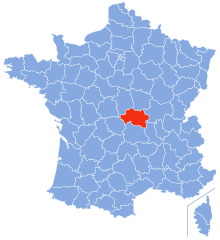Gouget noir

Gouget noir is a red
History

The origins of the name Gouget noir is not known. Some wine experts, such as
The grape's history in central France dates back at least to the 19th century where an 1843 document showed that it was used as both a wine and
Viticulture

Gouget noir is an
The grape is often confused for being
Wine regions
Today, Gouget noir is still found in the Allier and Cher regions but its numbers are far fewer from its pre-phylloxera plantings or even the 739 ha (1,826 acres) that were growing after World War II. The 2008 census of wine grape varieties counted only 10 ha (25 acres) of the grape, mostly found in the commune of Huriel in the Allier department.[1]
Synonyms
Over the years Gouget noir has been known under a variety of synonyms including: Gauget noir, Gouge, Gouge noir, Goujet, Lyonnais, Moret, Nérou, Neyrac, Neyran, Neyrou and Petit Neyran.[1][3]
References
- ^ ISBN 978-1-846-14446-2
- ISBN 0-15-100714-4
- ^ Vitis International Variety Catalogue (VIVC) Gouget noir Archived 2016-01-25 at the Wayback Machine Accessed: April 18th, 2013
